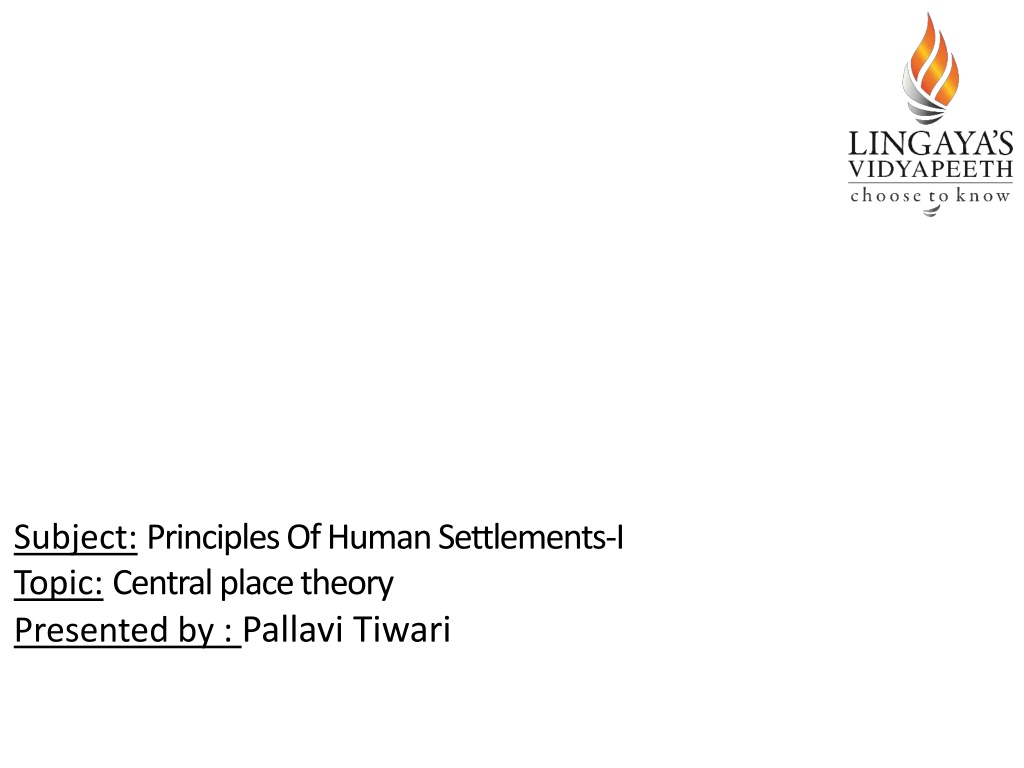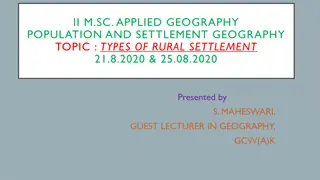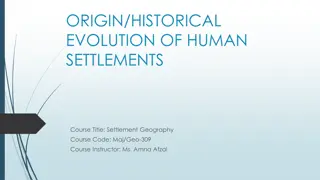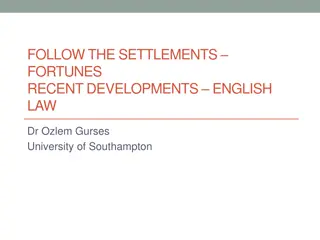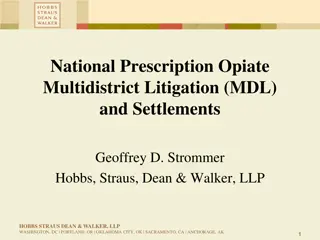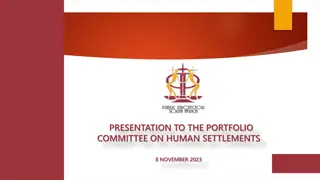Understanding Central Place Theory in Human Settlements
Central Place Theory explains the distribution and characteristics of human settlements within an urban system. It focuses on concepts like the range of service, threshold of service, and high vs. low order services. Christaller considered settlements as central places providing goods and services. This theory helps in understanding how different types of goods and services have varying ranges and thresholds based on population needs and technological advancements over time.
Download Presentation

Please find below an Image/Link to download the presentation.
The content on the website is provided AS IS for your information and personal use only. It may not be sold, licensed, or shared on other websites without obtaining consent from the author. Download presentation by click this link. If you encounter any issues during the download, it is possible that the publisher has removed the file from their server.
E N D
Presentation Transcript
Subject: Principles Of Human Settlements-I Topic: Central place theory Presented by : Pallavi Tiwari
Central Place Theory It is a geographical theory that seeks to explain the number, size and location of human settlements in an urban system.
HUMAN SETTLEMENTS:- Christaller considered the settlements as CentralPlaces which act as focus and provide goods and services for the surrounding area. PRINCIPAL OF THE THEORY :- RANGE OF SERVICE: It is the greatest distance that customers are willing to travel to the establishment. The range of a service can be regarded as the radius of a circle centered on the establishment. Different types of goods and services have ranges, e.g. Grocers: small range; department stores: large range i.e. high order goods are of a large range while for the lower order goods, they are of a small range. Moreover, ranges of goods vary between regions and change over time. e.g. Australian farmers travel much further for goods than Indian farmers due to the difference in transport technology. Example:- Range of goods varies over time owing to the advances in transport as people in most western nations are now prepared to travel further.
THRESHOLD OF A SERVICE: It is the minimum number of customers needed to support any service establishment that is the point at which the service establishment can begin trade profitably. (i.e. the minimum market size). Goods and services are produced to satisfy a demand. Some goods require a larger population than others to set up a sufficient level of demand to support a business supplying that commodity. Market thresholds differs from regions to regions. Moreover, market threshold changes over time which is due to the improvement in technology and the changes of tastes. The frequency of purchase of goods is a basic factor in influencing market thresholds.
CONCEPT OF HIGH ORDER SERVICE AND LOW ORDER SERVICES : A. Low order goods which most people buy frequently will have a low threshold, since the frequency of its purchase will create a profitable market even a relatively small population. Example : Foodstuff, sugar, butter soap, shampoo, salt, oil and barber shops. LOW ORDER SERVICE B. A. High order goods which are purchased infrequently will have high thresholds, since a large population will be needed to provide sufficient purchasers of it. These tend to be durable and costly commodities. Example :Motor vehicles, jewellery and most professional services. HIGH ORDER SERVICE B.
The effect is that the smaller central places serving a local population provide only the less costly and non-durable commodities, while the larger centers are able to support firms providing the more costly durable goods. Lower Limit or Threshold A population of this size (area x density of population) is required to sustain a good or service Upper Limit or Range At this point journey to centre is not worth while in relation to need for good or service. Cost or inconvenience outweigh need or alternative centre becomes available As a result of the interactions of threshold and range that a hierarchy of central places supplying goods and services of different orders will emerge. According to W. Christaller, the size and spacing of central places in an urban network maybe determined by market threshold and ranges of goods.
Assumptions of the theory: An isotropic surface is relatively uniform terrain, climate and soil over the landscape. Population is evenly distributed and they have the same income and the same demand for goods and services; Transport is equally easy in all directions and transport cost is proportional to distance and there is only one type of transport; Central places are located on the plain to provide goods and services and administrative functions to their immediate surrounding areas; Consumers visit the nearest central places in order to minimize the distance travelled; Businessmen as economic men, maximize their profit by locating at the place to gain largest profitable market. So centres of the same order would be located as far as possible from one another to maximize their marketing areas;
PATTERN AND SHAPE OF CENTRAL PLACES What's wrong with circles? What s wrong with circles
PATTERN AND SHAPE OF CENTRAL PLACES What's wrong with squares? What s wrong with circles
PATTERN AND SHAPE OF CENTRAL PLACES Finally, a hexagonal shape is found out to be the ideal shape. Both the average and maximum radial distance of a hexagon are only a little greater than in a circle of similar size. It has the great advantage of completely covering a region without overlapping or leaving areas unserved.
STRUCTURAL AND SPATIAL CHARACTERISTIC OF THE THEORY First order goods/ services smallest range and threshold; Second order goods/ services larger range and threshold; Third order goods/ services even larger range and threshold, - - -
THEORIES - K=3 The marketing principle Example -the highlighted lower order settlement (village X) will have 1/3 of is consumers go to the city (settlement A) and 1/3 will go to town Y and 1/3 will go to town Z (middle order settlements) The high order (3rd order) settlement (A) in the middle is surrounded by medium order settlements (black dots) and lower order settlements (small red dots). These consumers are attracted in equal amounts to whichever large central place is nearby. All the other lower order settlements (red dots) will follow the same pattern. Y Settlement X Z Why is K=3 called K=3? Hint look at the numbers of consumers who visit the highest order settlement
K4= The Traffic Principle In the K=4 model the lower order settlements (red dots) only have a choice of 2 higher order settlements to visit, in order to buy goods and services. How did K=4 get its name? -Half of them go to settlement A and the other half go to a medium order settlement (black dot) Why is K=4 called the Traffic Principle (model)
This model shows a hierarchy of control -Lower level settlements are arranged within the sphere of influence of the highest order settlement. This is done so that the lower order settlements can be completely controlled by higher levels. K=7 The Administrative Principle A high order central place is shown. -All the low order settlements lie within the hexagonal trade area (U,V,W,X,Y) Z U Y V Why is K7 called K7? X W
SIZE OF THE MARKET A higher order service needs a larger market area than a lower order service because its threshold is higher. If we measure the market area in km2, for example, if first order central place have market areas of 10 km2 for first order service, second order central place have market areas of 10 x 3 = 30 km2 for second order services.
SPACING OF THE CENTRAL PLACES . A higher order service needs a larger market area than a lower order service because its threshold is higher. If we measure the market area in km2, for example, if first order central place have market areas of 10 km2 for first order service, second order central place have market areas of 10 x 3 = 30 km2 for second order services.
Settlement hierarchy Why are there very few large settlements? Large settlements need a very large population (threshold) to support all of their functions (services) Large settlements provide very high order functions. Because these functions are so highly specialised there is not enough demand to support more than a few of them
Dr Shen Jianfa CUHK Geography CASE STUDY : URBAN SYSTEM IN HONG KONG 18
Shopping center planning in HK METROPOLITAN CENTERS Catchment population: Whole HK and tourists Range of goods: consumer durable goods, many banks and commercial services, cinemas, theatres, restaurants, entertainment and social facilities. Examples: located at Central, Tsim Sha Tsui and Causeway Bay 19
Dr Shen Jianfa CUHK Geography Shopping center planning in HK Regional Centers Catchment population: 250,000 to 1,000,000 Range of goods: department stores/supermarkets, many ancillary services, i.e. banks, restaurants, cinemas, theatres and other social facilities Examples: new town centers. Typical centers may range from 50,000 to 250,000 sq.m. 20
Dr Shen Jianfa CUHK Geography Shopping center planning in HK District Centers Catchment population: 50,000 to 250,000 Range of goods: limited entertainment and social facilities, but significant concentrations of retail facilities and restaurants Examples: medium-scale shopping centers of town-wide or district significance, Wan Chai in the urban area and Kam Tin in NT. Typical centers may range from 10,000 to 50,000 sq.m. 21
CASE STUDY : - URBAN HIERARCHY IN SOUTH-WEST GERMANY Settlement form Distance apart (km) Population Tributary area size (km2) Population Market hamlet (Markort) Township centre (Amtsort) County seat (Kreistadt) District city (Bezirksstadt) Small state capital (Gaustadt) Provincial head capital (Provinzhaupstadt) Regional capital city (Landeshaupstadt) 7 12 21 36 62 108 186 800 1,500 3,500 9,000 27,000 90,000 300,000 45 135 400 1,200 3,600 10,800 32,400 2,700 8,100 24,000 75,000 225,000 675,000 2,025,000
Limitations of Christaller's model The problem lies in the basic assumptions of the model: People do not always go to the nearest central place (they may chose a new edge of city superstore further away) So the K3 theory wouldn t work. Large areas of flat land rarely exist. Mountains & hills etc distort transport routes (so the K4 theory wouldn t work) People and wealth are not evenly distributed (if poorer people live in a certain area & their nearest high order settlement is expensive then they won t visit it) Governments often control where new towns are located, not market forces (i.e. not necessarily where the demand for goods and services is highest)
